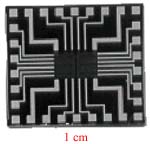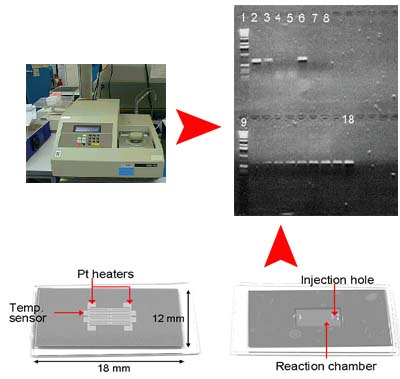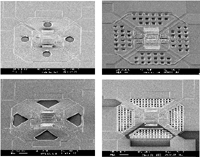Research
Area
The interdisciplinary nature of micro & nano systems has brought together
experts from many engineering research areas such as microfabrication technology,
mechanical design, material science, tribology, control theory, metrology, electrostatics,
robotics, and many science subjects such as physics, chemistry, and biology. Thus,
the research programs of the Institute are rather broad.
Fabrication and characterization and characterization
of micro devices & systems
Capabilities, such as deep reactive ion etching, fusion and anodic bonding
and electroplating, which are more specific to MEMS realization, will be added
to  enhance the
existing strength of the Microelectronic Fabrication Facility. These would remove
the constraint of working with limited film thickness (a few micrometers) using
conventional surface micro-machining techniques, thus allowing also the readlization
of "high-profile" devices. Others, such as advanced double-sides bond
aligner, would allow the fabrication of complicated 3-dimensional structure.
Focus will also be placed on identifying and characterizing new materials, which
might enhance MEMS performance or ease device integration by improving process
compatibility.
enhance the
existing strength of the Microelectronic Fabrication Facility. These would remove
the constraint of working with limited film thickness (a few micrometers) using
conventional surface micro-machining techniques, thus allowing also the readlization
of "high-profile" devices. Others, such as advanced double-sides bond
aligner, would allow the fabrication of complicated 3-dimensional structure.
Focus will also be placed on identifying and characterizing new materials, which
might enhance MEMS performance or ease device integration by improving process
compatibility.
Biochips
The research activities in the area are mainly focused on the development of
the genechip and lab-on-a-chip technology as well as niche applications.  The
program aims to develop in-house fabrication capabilities for high density genechip
arrays, PCR (polymerase chain reastion) chips, and microcapillary electrophoresis
systems. Niche applications will initially target TCM, including diagnostics
(identification of toxic TCMs or adulterated TCMs) , genomics, and drug discovery.
These areas have been selected on the basis of their immediate benefits to Hong
Kong and their ptential for providing a strong foundation by which to support
and encourage local investment and entrepreneurial initiatives. It is our vision
that these resarch activities will significantly contribute to and support:
(i) the establishment of a local genechip industry, and (ii) the local development
of biotechnology and biotechnology-oriented electronics, computer hardware,
and software industries.
The
program aims to develop in-house fabrication capabilities for high density genechip
arrays, PCR (polymerase chain reastion) chips, and microcapillary electrophoresis
systems. Niche applications will initially target TCM, including diagnostics
(identification of toxic TCMs or adulterated TCMs) , genomics, and drug discovery.
These areas have been selected on the basis of their immediate benefits to Hong
Kong and their ptential for providing a strong foundation by which to support
and encourage local investment and entrepreneurial initiatives. It is our vision
that these resarch activities will significantly contribute to and support:
(i) the establishment of a local genechip industry, and (ii) the local development
of biotechnology and biotechnology-oriented electronics, computer hardware,
and software industries.
Integrated transducers
Transducer receives signal and retransmits it in a different form. Transducers
are a key components in any nano- and microsystems. Transducers find  applications
in a wide range of areas. In biological system, as the result of some biochemical
reaction a signal was detected which can be used to trigger other biochemical
reactions. This type of transducer is critically important in Smart Laboratory-on-a-chip.
In environmental applications, transducers can detect air, water and food pollution.
In personalized telecommunication, transducers can sense the location which
a user is located so that appropriate wireless communication profile can be
enabled for the user as they move from one location to another. Possible areas
of research are biological / biochemical transducers, environmental transducers,
transducers for telecommunications. In each of the proposed area we should be
able to find application in Hong Kong as well as advance the state-of-the-art
in nano- and microsystems in the world
applications
in a wide range of areas. In biological system, as the result of some biochemical
reaction a signal was detected which can be used to trigger other biochemical
reactions. This type of transducer is critically important in Smart Laboratory-on-a-chip.
In environmental applications, transducers can detect air, water and food pollution.
In personalized telecommunication, transducers can sense the location which
a user is located so that appropriate wireless communication profile can be
enabled for the user as they move from one location to another. Possible areas
of research are biological / biochemical transducers, environmental transducers,
transducers for telecommunications. In each of the proposed area we should be
able to find application in Hong Kong as well as advance the state-of-the-art
in nano- and microsystems in the world
In addition, the combination of micro-optics and integrated optics with microelectronics
and micromechanics creates a broad class of micro-opto-electro-mechanical systems
(MOEMS). Many devices for potential applications such as laser diode correctors
/ collimators, adaptive fiber couplers, hybrid refractive-diffractive color
separators, fiber optic multiplexing, micro vision and illumination, optical
micro sensors, optical modulation and laser communication will be developed.
The ultimate goal is to construct low cost, portable, compact, robust micro
optical devices to replace current bulky, touchy, expensive optical systems.
Micro &nano fluidic systems
Micro & nano thermal systems
The MEMS community is introducing a wealth of microfabricated sensors, actuators,
pumps, and microfluidic devices whose functionality relies on heat transfer.
Attempts to optimize these devices demand a comprehensive understanding of the
fundamental thermal transport phenomena occurring at short length and time scales.
The research activities in this area will focus on the systematic investigations
in two-phase flow characteristics and phase-change heat transfer mechanisms
in microchannels and porous structures having nano-scale pores. Specific topics
include: 1) Bubble dynamics in microstructures; 2) Boiling and condensation
heat transfer in microchannels; 3) Micromachined silicon inverted-meniscus evaporators;
4) Phase-change-actuated micro pumps; 5) Microscale refrigeration systems; and
6) Two-phase flow and heat transfer in micro fuel cells.
Micro & nano chemical systems
Microreactors and membrane microseparators are parts of a new paradigm in chemical
engineering process that gave birth to microchemical system technology. Through
miniaturization, new opportunities in chemical production, material manufacture
and power generation can be  exploited
to satisfy the needs of a increasingly mobile society. It has been envisioned
that a complete microchemical device such as microfuel cells, will consist of
several major components responsible for fluid delivery, reaction and separation.
A smart unit may be included to monitor, control and coordinate the performance
of each of these components. A microfuel cell with power rating less than 100
W will have an enormous market demand as power unit for most portable devices
including cellular phones and computers. Central to the realization of a microfuel
cell device is the development of new electrode, catalyst and membrane materials
that will provide more effective energy generation.
exploited
to satisfy the needs of a increasingly mobile society. It has been envisioned
that a complete microchemical device such as microfuel cells, will consist of
several major components responsible for fluid delivery, reaction and separation.
A smart unit may be included to monitor, control and coordinate the performance
of each of these components. A microfuel cell with power rating less than 100
W will have an enormous market demand as power unit for most portable devices
including cellular phones and computers. Central to the realization of a microfuel
cell device is the development of new electrode, catalyst and membrane materials
that will provide more effective energy generation.
Micro-mechanics and micro-dynamics
Some fundamental scientific issues in solid mechanics and dynamics at the micrometer
scale are under study. Three key issues will be addressed: 1) assessment of
the testing methods for measuring the mechanical properties of MEMS materials,
so as to propose standardized testing procedures; 2) analyses of the major failure
mechanisms of micro structural components (e.g. micro-beams, micro-frames, micro-springs
and membranes) by taking into account of size effect and surface effect which
significantly influence the failure modes and criteria; and 3) examination of
dynamic factors (e.g. stress waves, inertia and strain-rate sensitivity of materials)
which influence the deformation and failure of micro components under shock
or impact loads.
Novel materials for micro & nano systems
The research activities in this area are primarily focused on the charaterization
of some smart materials such as piezoelectric materials, shape memory alloys
(SMAs) and shape memory polymers (SMPs), as well as their utilization in micro
systems. For instance, prototypes of SMA thin film micro-sensors and micro-actuators
are under development. Applications of SMAs in medical macro- and micro-surgery
will also be investigated. The application of ER fluids in transmitting forces
and nano-channel ion selective membranes for chemical sensors and medical analysis
will also be studied.
 enhance the
existing strength of the Microelectronic Fabrication Facility. These would remove
the constraint of working with limited film thickness (a few micrometers) using
conventional surface micro-machining techniques, thus allowing also the readlization
of "high-profile" devices. Others, such as advanced double-sides bond
aligner, would allow the fabrication of complicated 3-dimensional structure.
Focus will also be placed on identifying and characterizing new materials, which
might enhance MEMS performance or ease device integration by improving process
compatibility.
enhance the
existing strength of the Microelectronic Fabrication Facility. These would remove
the constraint of working with limited film thickness (a few micrometers) using
conventional surface micro-machining techniques, thus allowing also the readlization
of "high-profile" devices. Others, such as advanced double-sides bond
aligner, would allow the fabrication of complicated 3-dimensional structure.
Focus will also be placed on identifying and characterizing new materials, which
might enhance MEMS performance or ease device integration by improving process
compatibility.  The
program aims to develop in-house fabrication capabilities for high density genechip
arrays, PCR (polymerase chain reastion) chips, and microcapillary electrophoresis
systems. Niche applications will initially target TCM, including diagnostics
(identification of toxic TCMs or adulterated TCMs) , genomics, and drug discovery.
These areas have been selected on the basis of their immediate benefits to Hong
Kong and their ptential for providing a strong foundation by which to support
and encourage local investment and entrepreneurial initiatives. It is our vision
that these resarch activities will significantly contribute to and support:
(i) the establishment of a local genechip industry, and (ii) the local development
of biotechnology and biotechnology-oriented electronics, computer hardware,
and software industries.
The
program aims to develop in-house fabrication capabilities for high density genechip
arrays, PCR (polymerase chain reastion) chips, and microcapillary electrophoresis
systems. Niche applications will initially target TCM, including diagnostics
(identification of toxic TCMs or adulterated TCMs) , genomics, and drug discovery.
These areas have been selected on the basis of their immediate benefits to Hong
Kong and their ptential for providing a strong foundation by which to support
and encourage local investment and entrepreneurial initiatives. It is our vision
that these resarch activities will significantly contribute to and support:
(i) the establishment of a local genechip industry, and (ii) the local development
of biotechnology and biotechnology-oriented electronics, computer hardware,
and software industries. applications
in a wide range of areas. In biological system, as the result of some biochemical
reaction a signal was detected which can be used to trigger other biochemical
reactions. This type of transducer is critically important in Smart Laboratory-on-a-chip.
In environmental applications, transducers can detect air, water and food pollution.
In personalized telecommunication, transducers can sense the location which
a user is located so that appropriate wireless communication profile can be
enabled for the user as they move from one location to another. Possible areas
of research are biological / biochemical transducers, environmental transducers,
transducers for telecommunications. In each of the proposed area we should be
able to find application in Hong Kong as well as advance the state-of-the-art
in nano- and microsystems in the world
applications
in a wide range of areas. In biological system, as the result of some biochemical
reaction a signal was detected which can be used to trigger other biochemical
reactions. This type of transducer is critically important in Smart Laboratory-on-a-chip.
In environmental applications, transducers can detect air, water and food pollution.
In personalized telecommunication, transducers can sense the location which
a user is located so that appropriate wireless communication profile can be
enabled for the user as they move from one location to another. Possible areas
of research are biological / biochemical transducers, environmental transducers,
transducers for telecommunications. In each of the proposed area we should be
able to find application in Hong Kong as well as advance the state-of-the-art
in nano- and microsystems in the world exploited
to satisfy the needs of a increasingly mobile society. It has been envisioned
that a complete microchemical device such as microfuel cells, will consist of
several major components responsible for fluid delivery, reaction and separation.
A smart unit may be included to monitor, control and coordinate the performance
of each of these components. A microfuel cell with power rating less than 100
W will have an enormous market demand as power unit for most portable devices
including cellular phones and computers. Central to the realization of a microfuel
cell device is the development of new electrode, catalyst and membrane materials
that will provide more effective energy generation.
exploited
to satisfy the needs of a increasingly mobile society. It has been envisioned
that a complete microchemical device such as microfuel cells, will consist of
several major components responsible for fluid delivery, reaction and separation.
A smart unit may be included to monitor, control and coordinate the performance
of each of these components. A microfuel cell with power rating less than 100
W will have an enormous market demand as power unit for most portable devices
including cellular phones and computers. Central to the realization of a microfuel
cell device is the development of new electrode, catalyst and membrane materials
that will provide more effective energy generation.